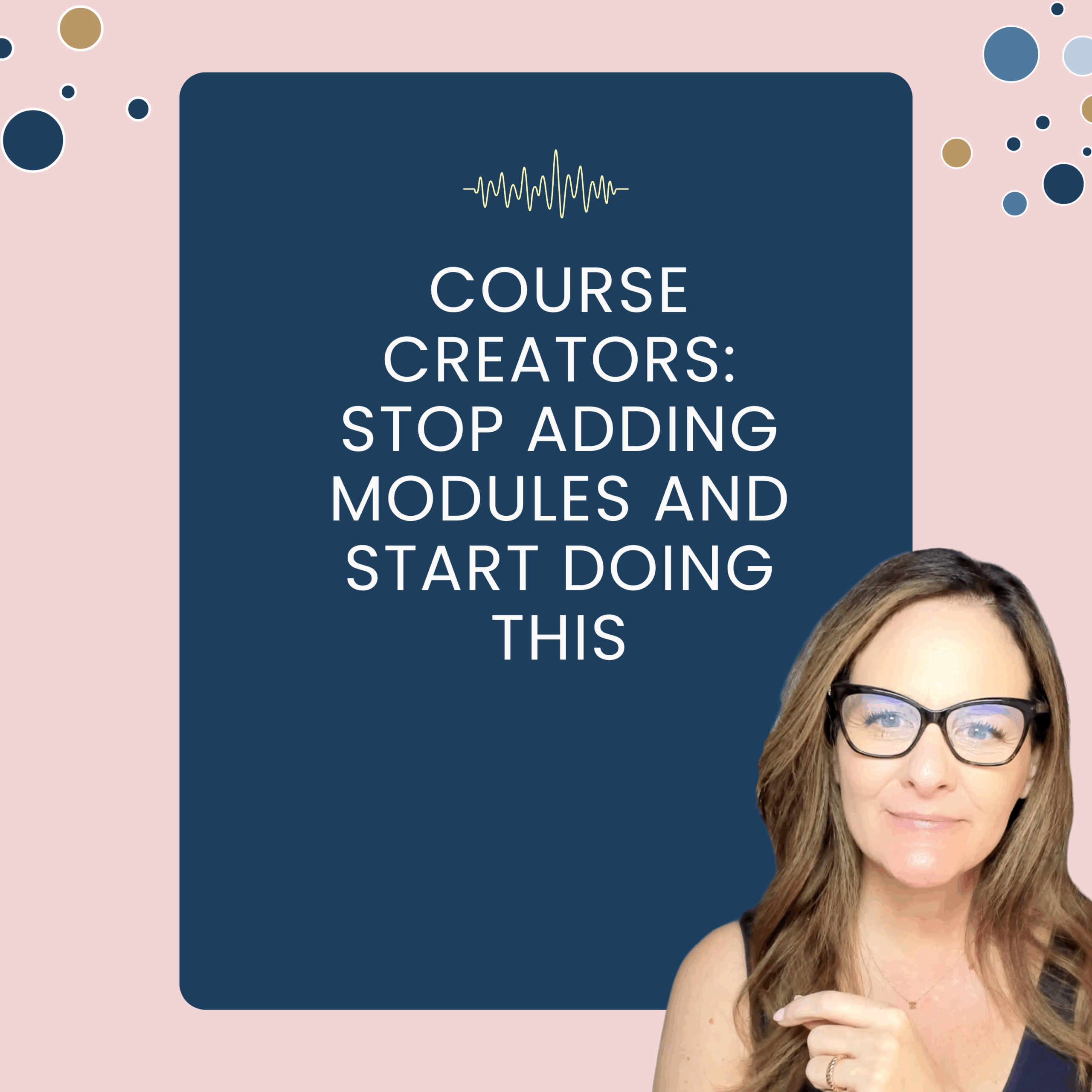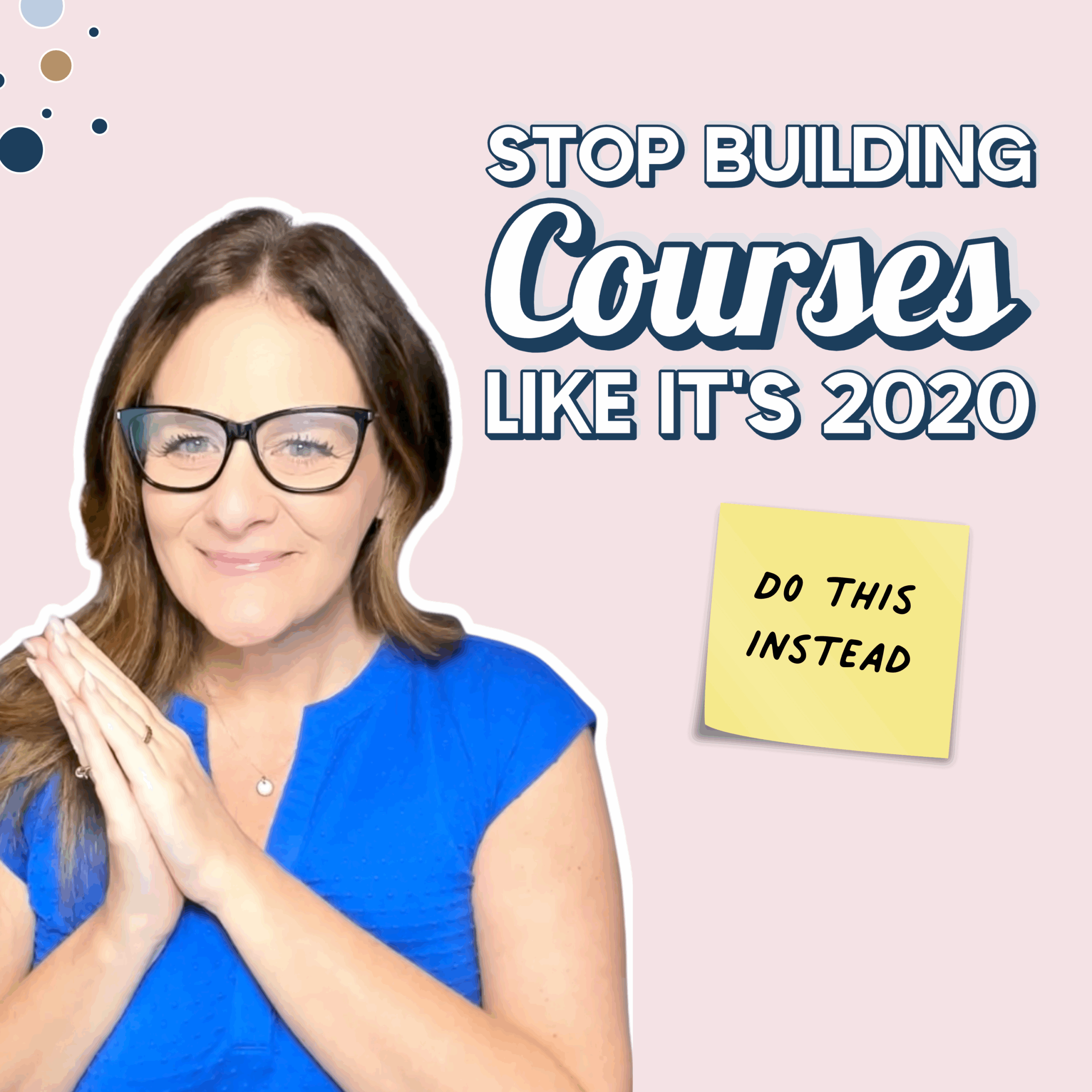🎧 Listen: Apple, Spotify, iHeart
I got an email last month from a course creator who was absolutely panicking.
She’d launched her program six months ago. Decent sales. Good feedback. But her completion rate was hovering around 12 percent.
So she did what most of us would do. She went back to the drawing board and asked herself, “What am I missing? What else do they need?”
Then she spent the next three months creating seven new modules. Advanced strategies. Bonus trainings. Deep-dive workshops. A whole resource library.
She relaunched with a big “now with even MORE content!” angle.
Her completion rate dropped to 8 percent.
She wrote back practically in tears. “I don’t understand. I gave them more. I made it better. Why are even fewer people finishing?”
Here’s the truth nobody wants to hear: More content isn’t the solution. It’s making the problem worse.
Your students aren’t struggling because they don’t have enough information. They’re struggling because they have too much of it, no support to implement it, and no accountability to actually do the work.
Why Adding More Course Content Backfires
We all have this instinct to add more when something isn’t working.
Students ask questions you didn’t cover. Someone wishes there was a module on X. Another person wants a deeper dive into Y.
Because you genuinely want students to succeed, you think, “I’ll add that. And that. And while I’m at it, this other thing too.”
Before you know it, your 8-module course has ballooned to 15 modules. Then 20. Plus a bonus vault that’s basically a second course.
In your mind: “This is so much value!”
From your student’s perspective: They log in. See 15 modules. Each with 4 lessons. Each lesson 20-30 minutes long.
That’s 20+ hours of content they need to fit between their full-time job, family, client work, and the 47 other things they’re juggling.
Instead of feeling excited, they feel overwhelmed.
They think, “When am I going to find time for all of this?”
That overwhelm is paralyzing. They watch module one, maybe two. Then life happens. They fall behind. Feel guilty. Eventually stop.
Not because your content isn’t good. Because there’s too much of it with no clear path through.
What Your Students Actually Want
Here’s what most course creators miss: Your students didn’t buy your course to consume content. They bought it to get a result.
They don’t want to spend 20 hours watching videos. They want to solve their problem and move on with their lives.
Every extra module moves them further from that result. Not closer.
The Content Consumption Trap
Picture a course on email marketing. Your student signs up to build their list and start making sales.
They log in and see modules on:
- List building
- Lead magnets
- Email sequences
- Subject lines
- Copywriting
- Segmentation
- Automation
- Analytics
- Deliverability
They think, “Okay, where do I start?”
Module one on list building is an hour long, covering organic growth, paid ads, collaborations, SEO, social media funnels…
They watch it. Take notes. Feel slightly overwhelmed.
Module two on lead magnets. Another hour. eBooks, templates, quizzes, challenges, webinars…
By the end of module two, they haven’t actually done anything yet.
And they have no idea which strategy to implement first. You gave them 10 options. They’re stuck in decision paralysis.
They think, “I’ll finish all the modules first, then implement.”
But we both know what happens. They never finish. Or if they do, they’re so overwhelmed they don’t know where to start.
The Better Approach: Implementation Over Information
Instead of a 60-minute module covering 10 different strategies, create a 15-minute focused lesson on one strategy.
Just one. No options. No “you could also try this.”
Here’s what to do, how to do it, why it works.
Then, instead of moving to module two, give students space to actually implement what they just learned.
This might look like:
- A community thread where they share their plan and get feedback
- Accountability check-ins where they report progress
- Live Q&A sessions to troubleshoot challenges
They take action immediately, with support, before moving to the next thing.
Here’s what’s wild: They’ll get better results from one 15-minute focused lesson with implementation support than from your 60-minute module with 10 strategies and no support.
Implementation beats information every single time.
Real Results: My Course Transformation
I had a program on building engaged communities. Originally 12 modules, each 30-45 minutes. Tons of information. Very comprehensive.
My completion rate was terrible. People finished modules 1-3, then disappeared.
I stripped it down. Twelve modules became six focused lessons, each 15-20 minutes max.
But I added structured implementation weeks after every lesson.
Students would watch the lesson, then have a full week to apply it with support from me and other students in a dedicated community space. We’d have a live Q&A mid-week. Students could post questions anytime.
At the end of each week, everyone shared what they implemented and learned before moving to the next lesson.
My completion rate went from 18% to 72%.
Same content. Actually, less content. But way more support around implementation.
The testimonials completely changed. Instead of “This course has so much great information,” I got “I actually built my community and it’s working.”
See the difference?
What to Focus on Instead of Adding Modules
1. Clarity Over Comprehensiveness
Your students don’t need every possible approach. They need one approach that works.
Give them the clearest, simplest path from where they are to where they want to be.
Stop trying to cover every edge case and advanced strategy. Those can come later, in a different offer.
Your course should solve one problem really well. Not five problems kind of well.
2. Implementation Over Information
After every lesson, ask: What should students DO with this information?
Not “think about it” or “reflect on it.” The actual action step.
Then build in time and support for them to take that action before moving on.
Implementation weeks, accountability threads, live co-working sessions, peer feedback groups — whatever helps them actually do the thing.
3. Support Over Self-Study
Most people can’t successfully complete a course alone in their office at 11 PM.
They need other humans. To ask questions when confused. To see others implementing the same concepts. To have someone notice if they disappear.
This doesn’t mean you’re available 24/7. But it does mean building in community support — a dedicated space, regular Q&A calls, or peer accountability.
4. Progress Over Perfection
Your students will implement your strategies imperfectly. That’s okay. That’s actually great.
Imperfect action beats perfect planning every time.
Stop trying to anticipate every scenario in your content. You can’t. You don’t need to.
Give them enough to take action. Support them as they figure out the details for their specific situation.
“But What About Students Who Want More?”
Here’s what I’ve learned: Students who are taking action and getting results never complain about not having enough content.
The only people who complain about “not enough” are those who aren’t implementing anything.
And you can’t course-create your way out of students not taking action. More modules won’t fix that. Structure, support, and accountability will.
What Would You Rather Have?
A course with 12 modules and a 15% completion rate, where most students feel like failures?
Or a course with 6 focused lessons and a 70% completion rate, where most students get real results?
From a business perspective, which students are more likely to:
- Buy your next offer
- Refer their friends
- Leave glowing testimonials
The ones who got results. Not the ones who got access to content they never used.
How to Fix an Existing Course with Too Much Content
Step 1: Check Your Completion Data
Where are students dropping off? That’s your clue.
If most abandon ship after module 3, you don’t need to improve modules 4-12. You need to figure out what’s happening at module 3.
Are they overwhelmed? Stuck on implementation? Confused about next steps?
Step 2: Ask Students Who Didn’t Finish
This feels vulnerable, but reach out to 5 students who didn’t complete your course. Ask honestly: what got in the way?
Most won’t say “not enough content.” They’ll say:
- “I fell behind and felt overwhelmed”
- “I wasn’t sure how to apply this to my situation”
- “Life got busy and I couldn’t keep up”
Those are problems you can solve without adding more content.
Step 3: Identify Your Core Path
If someone could only complete 3-5 lessons, which would get them the most important results?
That’s your core path. Everything else is bonus.
Restructure so the core path is super clear and achievable. Mark additional content as “go deeper” material for those who want it.
Step 4: Build in Implementation Support
Start with one thing:
- Weekly check-in threads
- Monthly live Q&As
- Peer accountability partnerships
Pick one supportive structure and test it. See what helps students take action.
The Bottom Line for Course Creators
Your course doesn’t need to be bigger. It needs to be more focused and better supported.
Course creators making real impact in 2025 aren’t the ones with the most modules or longest videos.
They’re the ones who understand transformation happens through implementation, not information.
And implementation requires clarity, support, and accountability — not more content.
If your course isn’t getting the completion rates or results you want, stop adding modules.
Focus on:
- Making the path clearer
- Making the lessons shorter
- Making the support stronger
Your students will thank you. Your testimonials will improve. Your course will finally deliver on its promise.
Need help restructuring your course for better results?
Join us in coCreator Society, where course creators, community builders, and creative entrepreneurs support each other instead of figuring everything out alone.
We’re kicking off a sprint in November focused on offers — whether that’s services, courses, or memberships. We’ll help you clarify what you’re selling, who it’s for, and how to position it so it lands.
No more building in a vacuum. Just focused work with people who understand what you’re creating.
→ Learn more and join coCreator Society
Your course isn’t broken. It just needs less stuff and more support.
TIMESTAMPS
- 00:00 The Dilemma of Course Completion Rates
- 01:45 Understanding the Overwhelm of Content
- 04:11 The Importance of Implementation Over Information
- 09:23 Strategies for Effective Course Design
- 15:49 Building Supportive Learning Environments






+ show Comments
- Hide Comments
add a comment